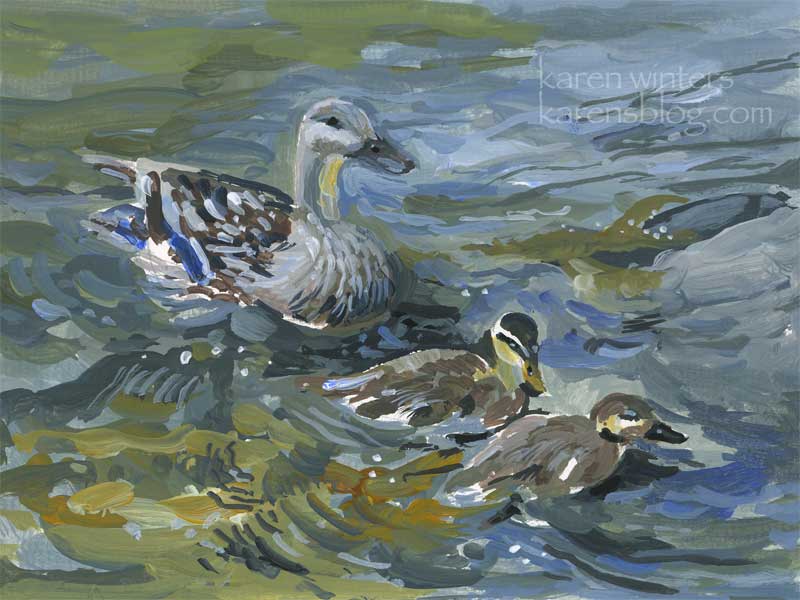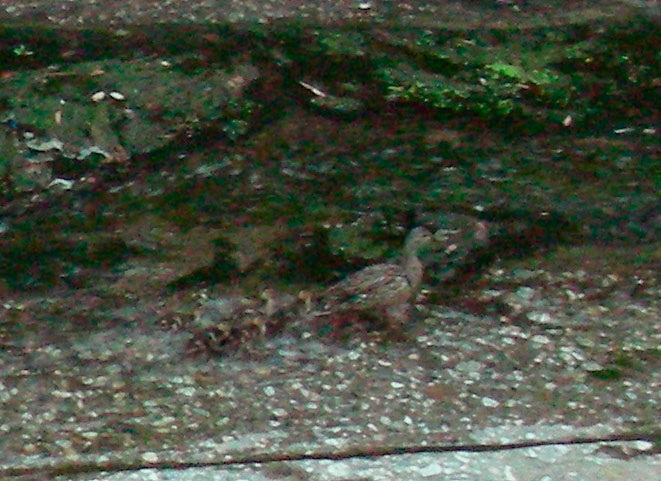The Ducklings and the Dam: An Art Fable
“Duck and ducklings” 6 x 8 acrylic on matboard
SOLD
On Saturday afternoon, just before sunset, my husband and son and I decided to take a walk in the Arroyo Seco area of Pasadena, which is spanned by several enormous bridges. A river runs through it, although this time of year it is usually a trickle. The river comes out of Hahamongna Park, another area that I like to go to paint and draw.
Having left the parking lot, we were heading toward the bridges when both my husband and I spied something extraordinary down in the flood channel: a mother duck was leading her five ducklings upstream. The channel, paved with cement, was mostly dry, but the area where they were walking (and they were walking, not paddling) was damp and slick with algae. The mother kept a brisk pace and the ducklings ran their little buns off trying to keep up with her. Where did they come from? How did they get down into the channel with its vertical sides which they clearly couldn’t get out of?
I was not concerned about them drowning. They are ducks after all and even if the meager flow in the channel increased, they could simply float on top of it. But I was worried about one hazard that lay ahead; a steep 45 degree ramp that formed the dam’s spillway that held back the upper pond. If they could not get out of the channel, the group would be easy picking for predators (such as owls) and night was approaching rapidly.
We gave up our desire for an aerobic walk and paced the ducks as they continued their trek. At times some of the smaller ones would take a tumble, but they quickly regained their footing and put on the speed to catch up with the group. The mother did not hesitate nor look back but would occasionally issue sharp quacks which I took to be a sort of encouragement to keep up. She set the pace and their imprinting forced them to follow.
Soon the steep ramp loomed ahead. We crossed a bridge and continued watching them as they approached this obstacle. We wondered how they would fare and held our breath. My husband was already assessing the situation and figuring a way down into the channel in case he had to do a rescue operation. That’s just the kind of man he is – always at the ready to help a damsel in distress.
The mother duck bravely led her charges up the ramp, avoiding the slick area and keeping to patches of dry paving. Her children struggled behind her but kept up the pace. But there was a final obstacle – a small protruding ledge, jutting out no more than 3 or 4 inches that they would have to go around. It was this ledge that had kept the slope dry for their ascent, but going around it and entering the pool of water at the top would mean stepping into a slippery stream of slime. We could practically see her assessing the situation and she opted to go around the corner of the ledge, her babies following. The safety of the pool was only a foot away, but the steep slippery slope was too great a match and she tumbled far down the slope, sweeping the ducklings with her. As soon as she recovered from the fall she turned around and headed back up the dry area again, and the ducklings followed. Thankfully, none seemed injured in the fall. As she approached the barrier ledge, this time she fluttered her wings and hopped over it. She was safe … but what about her brood?
The mother duck turned around and issued a few sharp quacks and the babies, unable to fly enough to get over the ledge, went around the ledge as they had before, but with their lighter mass and without the mother falling and carrying them down, four were able to scramble through the slippery scum and just barely get a webbed foothold on the top ledge, to join the other in the waiting pond.
The fifth duckling was not so fortunate and tumbled down the slope a second time. We were surprised to see that the mother duck was not anxiously looking over the ledge to see what happened to the final one. She had four to keep track of on top. Nature, or instinct probably told her to look after the greatest number. The fifth duckling shook itself off again, and with inspiring determination trudged up the slope a third time, got to the most treacherous part, fluttered and made it over the top to join the family. We, and some other walkers watching this episode all broke out in applause. The duck then quickly shepherded all the ducklings under some willow trees that were overhanging the pond. This, no doubt, would be their safe haven for the night. We saw her later diving for food in the pond, but the babes were nowhere to be seen.
Questions arose that we will never have answers for. Had the family been nesting elsewhere and just decided to relocate? Or were they always living in the upper pond and the mother had taken them all out for exercise and strengthening. Had she been a duck raised in that area or was she from somewhere else? Where was the drake? Was she unconcerned about the fate of the fifth duckling when she turned her attention to the others? Was she obeying an instinct that told her to keep her eye on the greatest number? Or did she have faith that the last little one would make it?
And what, if anything, does all of this have to do with making art?
Here’s what I’ve learned from these duck adventures:
1. Getting where you want to go isn’t always easy and it isn’t always fun. It can be a lot of hard work just trying to keep up. But whining and falling behind really isn’t an option.
2. When you’re on a journey (creative or otherwise) it’s good to have companions to help you keep the pace. Make friends with other artists and take part in activities that challenge you. “Play up” as they say in sports. Do things with people who are more skilled and experienced than you are. Be inspired by their determination and energy.
3. Find a good mentor who knows the way and who will lead by example. The mother duck didn’t try to carry the babies on her back or worry about whether they were all comfortable and having a good time. (“Are we there yet?”) She set the pace and the expectations. She didn’t nag, cajole or make snarky comments about their paddling technique. A few directive quacks seemed to be enough to keep the group in line. Imprinting and instinct did the rest.
4. Unexpected obstacles will arise. Take them in stride. Just when you think that your journey is going to be a walk in the park, you come upon a 45 degree wall of slime with only a small semi-dry pathway to the top. Try to avoid the slime if you can. And if you can’t …
5. Don’t let a setback (or two, or three) stop your journey. If you’re pushing yourself you will certainly face seemingly insurmountable problems. But the truth is, everyone trips. Everyone falls. Everyone makes a fluttering, crashing spectacle of themselves at one time or another. But those are learning experiences and the next time you face the obstacle you might just try something different or decide to gather yourself together and muscle your way through. If you’re a duckling, failure and giving up is not an option. Don’t make it an option for you, either. Even if you’re the fifth duckling and everyone else has “arrived”, keep going. You can all party and pig-out on polliwogs at the top.
6. Struggle makes you stronger. My guess is that those ducklings were going to sleep well Saturday night. But Sunday morning they’d be stronger and more experienced than if they hadn’t had that field trip. Maybe the mother duck knew that, too. If you avoid a certain type of drawing or painting, tackle it. Face the hill.
Below: The real mom and ducklings in the channel. Sorry it’s not a good picture but low light conditions, distance and shooting through a chain link fence complicated things



